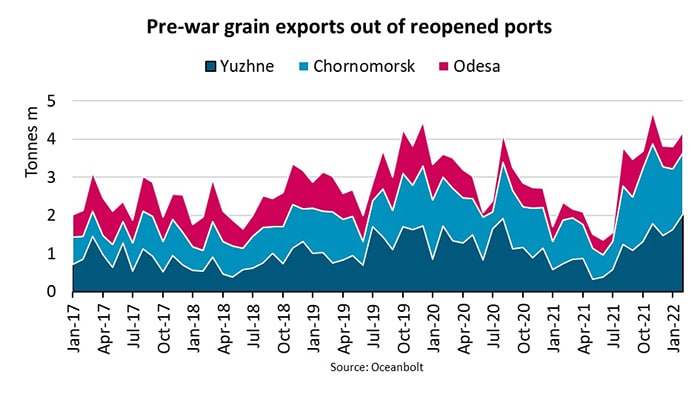
Grain export agreement could see 65% of Ukraine’s seaborne capacity reopen
Written by Nick Blenkey
U.K. says newest Russian threat to merchant ships is sea mines [Romanian Navy photograph]
There are at least a few hopeful signs that seaborne exports of Ukrainian grain could resume within days. Under a deal brokered by Turkey on July 22, bulkers will be escorted to the ports through a safe corridor. To create a navigable passage, the corridor will have to have sea mines cleared, a process that is expected to take one to two weeks.
The BBC today quoted Ukraine as saying work has started at three ports, aimed at forming “green corridors” to allow grain exports. Presumably that work will include mine clearance. A spokesperson for the Odesa military administration told the BBC that naval teams will build routes out of southern ports in Odesa, Chornomorsk and Pivdennyi (Yuzhne). Once the routes are established, “caravans” of ships led by Ukrainian naval vessels will sail through the Black Sea.
In another positive move, Turkish Defense Minister Hulusi Akar today unveiled a center in Istanbul to oversee the export of Ukrainian grain under the terms of the agreement. The joint coordination center (JCC) will oversee departures from three Ukrainian ports in which ships must circumvent mines, and will conduct inspections of incoming ships for weapons. A total of 20 personnel from Ukraine, Russia, Turkey and the United Nations will work side-by-side at the JCC.
CHALLENGING TARGET
According to BIMCO, the three ports now being readied to resume operations accounted for 65% of Ukraine’s total grain exports over the past five years.
“With this deal, the UN hopes to increase monthly grain exports from Ukraine by five million tonnes. However, since over the past five years, these three ports have not ever handled such a high amount of grain, meeting this target could prove to be a challenge,” says Niels Rasmussen, Chief Shipping Analyst at BIMCO. “Even if port logistics accelerate to expedite exports, the need to escort ships in and out of the ports is likely to cause some congestion.”

Over 20 million tonnes of Ukrainian grains are ready for export and the country’s grain traders union (UGA) expects around 25 million tonnes more to come from the 2022 harvest, says BIMCO. With the wheat harvest underway and the maize harvest to start in September, a swift export of grain is needed to ensure space in silos for the new harvests. To accelerate exports the Danube ports, as well as land routes, will likely continue to play an important role in the shipment of Ukrainian grain in the short to medium term.
“A significant obstacle to Ukrainian grain exports will be the voyage risk and corresponding insurance premiums. For the shipping of Ukrainian grain to be attractive, high rates will be necessary to mitigate risk-related expenses,” says Rasmussen. “Russia’s recent missile strikes in ports such as Odesa will add to the insecurity and uncertainty of operating in the Black Sea.”
Due to limited global supply of wheat and maize, a return of Ukrainian grain to the global market would positively impact the Panamax, Supramax and Handysize segments. Additionally, the boost in Ukrainian exports would help combat inflation and food insecurity, particularly in emerging economies, and help bring needed stability to the global economy.




